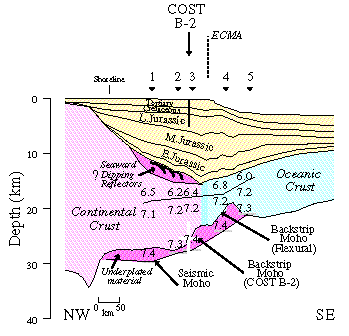Prof. Anthony B. Watts
Professor of Marine Geology and Geophysics
The subsidence history of passive continental margins
Passive continental margins form by continental rifting and the creation of new ocean basins. Some margins are characterised by relatively thin sediments and either an absence (e.g., Goban Spur) or abundance (e.g.,Voring Plateau) of magmatic material. Evidence for magmatism occurs either in the form of seaward dipping reflector sequences or high P-wave velocity (i.e. > 7.3 km s-1) underplated lower crustal bodies or some combination of these features. Others (e.g., East Coast, USA) correlate with large thicknesses of sediments (> 10 km) which make it difficult to evaluate the role of magmatism. While differences in the amounts of sediments and magmatism explain the diversity of present-day margins, they obscure the geometry, styles and mechanics of initial rifting.
One approach to the problem is by backstripping. This is a quantitative technique which allows the contribution to the subsidence and uplift of sediment loading to be evaluated at a well site, along a seismic reflection profile or, over a isopach map. Backstripping yields the depth that basement would be in the absence of sediment and water loads and, hence, the shape of the water-filled basin that resulted from rifting. Examples of backstripping well data in the East Coast, USA and UK margins are summarised in the figures below. We note that while the genral shape of the backstripped subsidence and uplift are similar for the two margins, there are differences. The backstrip at the COST B-3 well is well explained by a mid-oceanic ridge model whereas the backstrip at Site 552 is some 1.5 km shallower than would be expected by a ridge model.

We know from isostatic considerations that the Earth's crust and upper mantle would be unable to support a wide, deep, water-filled depression without some form of compensation. In rift-type margins, the compensation usually takes the form of a thinning or necking of the crust. The subsidence and uplift derived from backstripping is therefore some function of the amount of this thinning. Usually, studies assume that the thinning can be computed from the backstrip assuming a local Airy-type model of isostasy. An example of such a calculation is shown in the figure below. Two calculations are shown in the figure : one is based on the backstrip at the COST B-2 well while the other is based on a flexural backstrip of the sediments along a profile. The calculated depth to Moho agrees reasonably well with the depth determined seismically. Thus, Moho is at the depth that would be expected given the rifting and sediment loading history. There is a discrepency (the calculated Moho is deeper than the seismic Moho) suggesting that a small amount of material may have been added to the crust.
Although the assumption of Airy isostasy during rifting may be justified by higher lithospheric temperatures and widespread normal faulting, it seems unlikely that all margins will show such fundamental weakness at the time of rifting. Margins form by rifting, yet many continental rifts are flanked by rim uplifts which appear to require a high flexural rigidity. We have been developing techniques that will use the backstrip to determine the crustal structure at the time of rifting that take into account a finite strength during rifting as well as the possibility that a net downward or upward force may act on the crust and upper mantle during rifting.

Collaborators: Christine Peirce (Durham), Ingo Grevemyer (IFM-GEOMAR, Germany)
Return to Tony Watts home page

